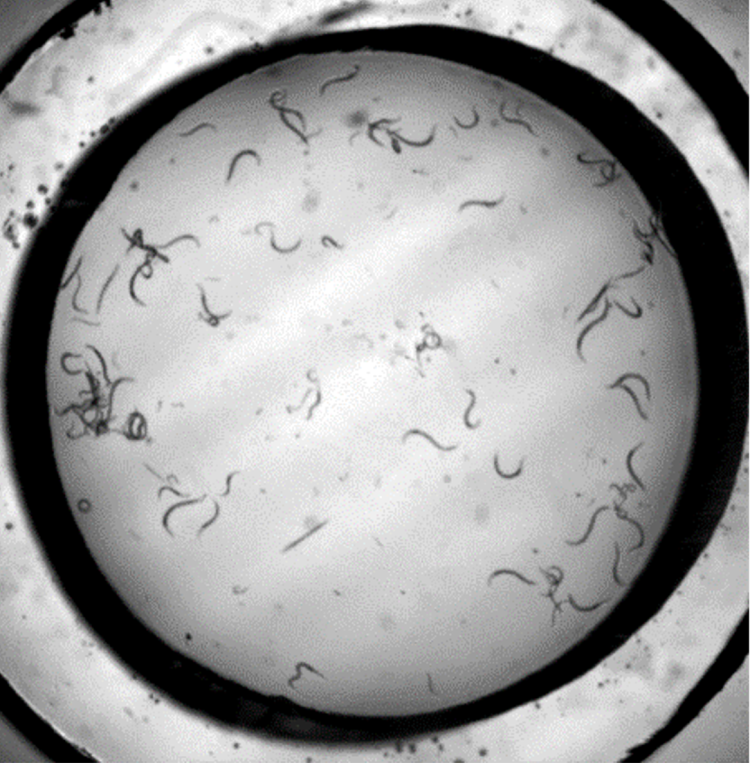A team of biologists and engineers at CU Boulder recently led an exercise class for tiny worms-and their findings could one day help doctors treat humans with Parkinson's disease and similar illnesses.
The study dives into the incredibly small world of Caenorhabditis elegans. These swimming nematode worms measure just 1 millimeter long. They have only 302 neurons, or nervous system cells, compared to the billions in a human brain, said Ding Xue, co-author of the new research and professor in the Department of Molecular, Cellular & Developmental Biology (MCDB). But the neurons they do have work a lot like our own.
"C. elegans is probably the smallest animal that has all of the important cellular pathways that you find in humans," Xue said.
In their latest study, published Feb. 22 in the journal Science Advances, the team designed a miniature facility called the "Acoustic Gym," which is about the size of a quarter. The device uses sound waves to generate gentle whirlpools inside a reservoir of liquid, forcing C. elegans to swim against the current.
"Previously, the only way to study exercise in C. elegans was to, essentially, put them into a small container and shake it or let them swim as they wish," said study co-author Xiaoyun Ding, assistant professor in the Paul M. Rady Department of Mechanical Engineering. "With this new device, we can precisely control the intensity and duration of their swimming."
The researchers used the gym to examine the effect of exercise on a group of worms that lose neurons over time following a pattern similar to humans with Parkinson's-a neurologic disease in which people experience tremors and have trouble moving, among other symptoms. That degeneration, however, seemed to slow down in worms that swam for just the right amount of time.
"Too little or too much exercise doesn't achieve the beneficial effect," Xue said. "There's a sweet spot."
Riding a bike
The biologist's own interest in the brain and exercise dates back several years. Xue was watching the nightly news when he saw a story about a man with Parkinson's disease whose symptoms improved when he went for a bike ride.
"After a bike ride, this patient suddenly became much more stable, and he was able to hold objects better," Xue said. "I thought: 'Maybe we could do something with that.'"
Studying exercise in real human patients, however, is not always easy. Many people with Parkinson's, for example, are older or can't balance well enough to exercise consistently.
The researcher, who has studied the cellular underpinnings of a wide variety of diseases, decided to turn to his old friend C. elegans.
Gym-on-a-chip
Xue and his team joined forces with Ding's lab to create the perfect piece of exercise equipment for very small gym junkies. The researchers' gym-on-a-chip includes a well that they can fill up with liquid and is the perfect size for C. elegans. Joyita Bhadra, a postdoctoral researcher in MCDB, and Nakul Sridhar, a graduate student in mechanical engineering, are co-lead authors of the new study.
"The well is about 10 times larger than C. elegans," Ding said. "It's equivalent to how large a swimming pool is for humans."
In the study, the researchers dropped worms into these wells, then created slow waves that moved in a circle. The swimming exercises didn't pose any harm to the worms, the team reports.
The researchers focused on two groups of C. elegans worms that scientists had genetically engineered to mimic human neurologic illnesses. One of these mutants, for example, has eight "dopaminergic" neurons (cells that produce dopamine, an important molecule in the body and brain), which degrade and even die off over the animal's lifetime. Parkinson's disease affects the same kind of cells in human brains.
Exercise, however, could slow that loss.
With a little trial and error, the group discovered that swimming for just 5 minutes once a day for two days reduced the degradation of neurons in C. elegans by 28%, on average.
"If they only swim for 2 minutes, it doesn't work," Xue said. "If you force them to swim for 10 minutes, it doesn't work."
Xue isn't sure why exercise seems to help the worms. It may come down to the chemical biproducts that animals make when they flex their muscles. For now, the researchers want to use their gym-on-a-chip to start looking for new drugs that might be able to treat the symptoms of Parkinson's disease-all the benefits of exercise, without the exercise.
"For the first time, we have a platform to begin screening for drugs that could, for example, replace the beneficial effects of exercise," Xue said. "That could be really good for elderly people or others who aren't able to exercise."
Co-authors of the new research include Apresio Kefin Fajrial, a graduate student in mechanical engineering at CU Boulder, and MCDB undergraduate student Nia Hammond.








